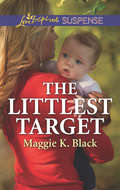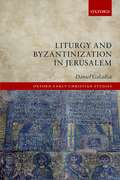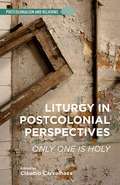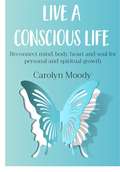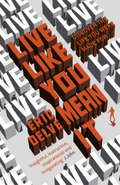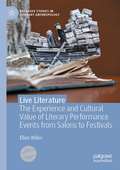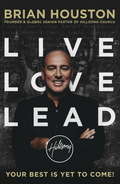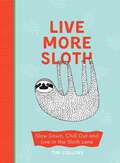- Table View
- List View
A Little Light On The Spiritual Laws
by Diana CooperA Little Light on the Spiritual Laws sets out clearly and simply 36 Spiritual Laws which govern life on Earth. Vividly illustrated with stories and metaphors, it shows how to achieve prosperity, success, gratitude and purification. If you do not understand the rules of the game you cannot play in the top league. In the same way you cannot be happy, healthy and successful until you understand the Laws of Life. This book offers a definitive, accessible guide to mastering life and when practised at the highest level, it contains the keys to heaven.
Little Miss Matchmaker (A Tiny Blessings Tale #5)
by Dana CorbitTo: Uncle Alex From: Chelsea Re: I think you should ask Miss Fraser on a date She's my favorite teacher ever and she definitely likes you, I can tell. Everyone in town knows you're this brave firefighter. So why don't you be the hero of Miss Fraser's life? Maybe you could volunteer together at the Chestnut Grove Youth Center.
The Littlest Target: Guarding The Babies The Littlest Target Fugitive Spy (True North Heroes #2)
by Maggie K. BlackNanny and baby on the run A taut thriller in the True North Heroes series
The Littlest Witness: Small Town Justice Compromised Identity The Littlest Witness (Mills And Boon Love Inspired Suspense Ser.)
by Jane M. ChoateTo protect a child
Liturgical Spirituality
by Philip H. PfatteicherWell-known liturgical scholar and writer Philip Pfatteicher turns his attention in this book to "liturgical spirituality" as distinct from "liturgy and spirituality," which assumes two essentially separate disciplines."Liturgical spirituality" is a holistic concept, bringing together both liturgy and spirituality with reference to the interior life of the spirit that is formed and nurtured by the church's liturgy. Pfatteicher acknowledges that there are other kinds of spirituality that appear to flourish apart from and in addition to the liturgy: for example, the spirituality of the desert ascetics of the early centuries of christianity, the devotion of the Religious Society of Friends, and many forms of meditation and spiritual discipline such as the Spiritual Exercise of Ignatius Loyola. The focus of the present volume, however, is on the spiritual life as formed by the liturgy, the ordered form of Christian worship, East and West, Catholic and Protestant.In addition to the form of worship one might experience on a Sunday morning, Liturgical Spirituality guides the reader through and into the experience of daily prayer, the Easter Vigil, the Church Year, the Eucharist, hymns and music, Baptism, and even church architecture as "hallowing space."In 1955 Louis Bouyer published an admirable study entitled Liturgical Piety, written before Vatican II and its far-reaching reforms that fundamentally changed the entire Western church. Philip Pfatteicher has now taken up the challenge of expanding upon Bouyer with a current and invigorating study not of "liturgical piety" but of "liturgical spirituality."Philip Phatteicher is Professor of English at East Stroudsburg University in Pennsylvania, a frequent writer and lecturer on liturgical issues, and author of A Dictionary of Liturgical Terms and The School of the Church: Worship and Christian Formation, both published by Trinity Press.
The Liturgies of Quakerism (Liturgy, Worship and Society Series)
by Pink DandelionThe Liturgies of Quakerism explores the nature of liturgy within a form of worship based in silence. Tracing the original seventeenth century Quakers' understanding of the 'liturgy of silence', and what for them replaced the outward forms used in other parts of Christianity, this book explains how early Quaker understandings of 'time', 'history', and 'apocalyptic' led to an inward liturgical form. The practices and understanding of twenty-first century Liberal Quakers are explored, showing that these contemporary Quakers maintain the same kind of liturgical form as their ancestors and yet understand it in a very different way. Breaking new ground in the study of Quaker liturgy, this book contrasts the two periods and looks at some of the consequences for the study of liturgy in general, and Quakerism in particular. It also explores evangelical Quaker understandings of liturgy.
The Liturgies of Quakerism (Liturgy, Worship and Society Series)
by Pink DandelionThe Liturgies of Quakerism explores the nature of liturgy within a form of worship based in silence. Tracing the original seventeenth century Quakers' understanding of the 'liturgy of silence', and what for them replaced the outward forms used in other parts of Christianity, this book explains how early Quaker understandings of 'time', 'history', and 'apocalyptic' led to an inward liturgical form. The practices and understanding of twenty-first century Liberal Quakers are explored, showing that these contemporary Quakers maintain the same kind of liturgical form as their ancestors and yet understand it in a very different way. Breaking new ground in the study of Quaker liturgy, this book contrasts the two periods and looks at some of the consequences for the study of liturgy in general, and Quakerism in particular. It also explores evangelical Quaker understandings of liturgy.
Liturgy and Architecture: From the Early Church to the Middle Ages (Liturgy, Worship and Society Series)
by Allan DoigIn this book Allan Doig explores the interrelationship of liturgy and architecture from the Early Church to the close of the Middle Ages, taking into account social, economic, technical, theological and artistic factors. These are crucial to a proper understanding of ecclesiastical architecture of all periods, and together their study illuminates the study of liturgy. Buildings and their archaeology are standing indices of human activity, and the whole matrix of meaning they present is highly revealing of the larger meaning of ritual performance within, and movement through, their space. The excavation of the mid-third-century church at Dura Europos in the Syrian desert, the grandeur of Constantine's Imperial basilicas, the influence of the great pilgrimage sites, and the marvels of soaring Gothic cathedrals, all come alive in a new way when the space is animated by the liturgy for which they were built. Reviewing the most recent research in the area, and moving the debate forward, this study will be useful to liturgists, clergy, theologians, art and architectural historians, and those interested in the conservation of ecclesiastical structures built for the liturgy.
Liturgy and Architecture: From the Early Church to the Middle Ages (Liturgy, Worship and Society Series)
by Allan DoigIn this book Allan Doig explores the interrelationship of liturgy and architecture from the Early Church to the close of the Middle Ages, taking into account social, economic, technical, theological and artistic factors. These are crucial to a proper understanding of ecclesiastical architecture of all periods, and together their study illuminates the study of liturgy. Buildings and their archaeology are standing indices of human activity, and the whole matrix of meaning they present is highly revealing of the larger meaning of ritual performance within, and movement through, their space. The excavation of the mid-third-century church at Dura Europos in the Syrian desert, the grandeur of Constantine's Imperial basilicas, the influence of the great pilgrimage sites, and the marvels of soaring Gothic cathedrals, all come alive in a new way when the space is animated by the liturgy for which they were built. Reviewing the most recent research in the area, and moving the debate forward, this study will be useful to liturgists, clergy, theologians, art and architectural historians, and those interested in the conservation of ecclesiastical structures built for the liturgy.
Liturgy and Byzantinization in Jerusalem (Oxford Early Christian Studies)
by Daniel GaladzaThe Church of Jerusalem, the 'mother of the churches of God', influenced all of Christendom before it underwent multiple captivities between the eighth and thirteenth centuries: first, political subjugation to Arab Islamic forces, then displacement of Greek-praying Christians by Crusaders, and finally ritual assimilation to fellow Orthodox Byzantines in Constantinople. All three contributed to the phenomenon of the Byzantinization of Jerusalem's liturgy, but only the last explains how it was completely lost and replaced by the liturgy of the imperial capital, Constantinople. The sources for this study are rediscovered manuscripts of Jerusalem's liturgical calendar and lectionary. When examined in context, they reveal that the devastating events of the Arab conquest in 638 and the destruction of the Holy Sepulchre in 1009 did not have as detrimental an effect on liturgy as previously held. Instead, they confirm that the process of Byzantinization was gradual and locally-effected, rather than an imposed element of Byzantine imperial policy or ideology of the Church of Constantinople. Originally, the city's worship consisted of reading scripture and singing hymns at places connected with the life of Christ, so that the link between holy sites and liturgy became a hallmark of Jerusalem's worship, but the changing sacred topography led to changes in the local liturgical tradition. Liturgy and Byzantinization in Jerusalem is the first study dedicated to the question of the Byzantinization of Jerusalem's liturgy, providing English translations of many liturgical texts and hymns here for the first time and offering a glimpse of Jerusalem's lost liturgical and theological tradition.
Liturgy and Byzantinization in Jerusalem (Oxford Early Christian Studies)
by Daniel GaladzaThe Church of Jerusalem, the 'mother of the churches of God', influenced all of Christendom before it underwent multiple captivities between the eighth and thirteenth centuries: first, political subjugation to Arab Islamic forces, then displacement of Greek-praying Christians by Crusaders, and finally ritual assimilation to fellow Orthodox Byzantines in Constantinople. All three contributed to the phenomenon of the Byzantinization of Jerusalem's liturgy, but only the last explains how it was completely lost and replaced by the liturgy of the imperial capital, Constantinople. The sources for this study are rediscovered manuscripts of Jerusalem's liturgical calendar and lectionary. When examined in context, they reveal that the devastating events of the Arab conquest in 638 and the destruction of the Holy Sepulchre in 1009 did not have as detrimental an effect on liturgy as previously held. Instead, they confirm that the process of Byzantinization was gradual and locally-effected, rather than an imposed element of Byzantine imperial policy or ideology of the Church of Constantinople. Originally, the city's worship consisted of reading scripture and singing hymns at places connected with the life of Christ, so that the link between holy sites and liturgy became a hallmark of Jerusalem's worship, but the changing sacred topography led to changes in the local liturgical tradition. Liturgy and Byzantinization in Jerusalem is the first study dedicated to the question of the Byzantinization of Jerusalem's liturgy, providing English translations of many liturgical texts and hymns here for the first time and offering a glimpse of Jerusalem's lost liturgical and theological tradition.
Liturgy and Society in Early Medieval Rome (Church, Faith and Culture in the Medieval West)
by John F. RomanoThe liturgy, the public worship of the Catholic Church, was a crucial factor in forging the society of early medieval Rome. As the Roman Empire dissolved, a new world emerged as Christian bishops stepped into the power vacuum left by the dismantling of the Empire. Among these potentates, none was more important than the bishop of Rome, the pope. The documents, archaeology, and architecture that issued forth from papal Rome in the seventh and eighth centuries preserve a precious glimpse into novel societal patterns. The underexploited liturgical sources in particular enrich and complicate our historical understanding of this period. They show how liturgy was the ’social glue’ that held together the Christian society of early medieval Rome - and excluded those who did not belong to it. This study places the liturgy center stage, filling a gap in research on early medieval Rome and demonstrating the utility of investigating how the liturgy functioned in medieval Europe. It includes a detailed analysis of the papal Mass, the central act of liturgy and the most obvious example of the close interaction of liturgy, social relations and power. The first extant Mass liturgy, the First Roman Ordo, is also given a new presentation in Latin here with an English translation and commentary. Other grand liturgical events such as penitential processions are also examined, as well as more mundane acts of worship. Far from a pious business with limited influence, the liturgy established an exchange between humans and the divine that oriented Roman society to God and fostered the dominance of the clergy.
Liturgy and Society in Early Medieval Rome (Church, Faith and Culture in the Medieval West)
by John F. RomanoThe liturgy, the public worship of the Catholic Church, was a crucial factor in forging the society of early medieval Rome. As the Roman Empire dissolved, a new world emerged as Christian bishops stepped into the power vacuum left by the dismantling of the Empire. Among these potentates, none was more important than the bishop of Rome, the pope. The documents, archaeology, and architecture that issued forth from papal Rome in the seventh and eighth centuries preserve a precious glimpse into novel societal patterns. The underexploited liturgical sources in particular enrich and complicate our historical understanding of this period. They show how liturgy was the ’social glue’ that held together the Christian society of early medieval Rome - and excluded those who did not belong to it. This study places the liturgy center stage, filling a gap in research on early medieval Rome and demonstrating the utility of investigating how the liturgy functioned in medieval Europe. It includes a detailed analysis of the papal Mass, the central act of liturgy and the most obvious example of the close interaction of liturgy, social relations and power. The first extant Mass liturgy, the First Roman Ordo, is also given a new presentation in Latin here with an English translation and commentary. Other grand liturgical events such as penitential processions are also examined, as well as more mundane acts of worship. Far from a pious business with limited influence, the liturgy established an exchange between humans and the divine that oriented Roman society to God and fostered the dominance of the clergy.
Liturgy in Postcolonial Perspectives: Only One Is Holy (Postcolonialism and Religions)
by Cláudio CarvalhaesThis book brings Christian, Jewish and Muslim scholars from different fields of knowledge and many places across the globe to introduce/expand the dialogue between the field of liturgy and postcolonial/decolonial thinking. Connecting main themes in both fields, this book shows what is at stake in this dialectical scholarship.
Liturgy in the Twenty-First Century: Contemporary Issues and Perspectives
by Alcuin Reid'Because the Sacred Liturgy is truly the font from which all the Church's power flows...we must do everything we can to put the Sacred Liturgy back at the very heart of the relationship between God and man... I ask you to continue to work towards achieving the liturgical aims of the Second Vatican Council...and to work to continue the liturgical renewal promoted by Pope Benedict XVI, especially through the post-synodal apostolic exhortation Sacramentum Caritatis...and the motu proprio Summorum Pontificum... I ask you to be wise, like the householder...who knows when to bring out of his treasure things both new and old (see: Mtt 13:52), so that the Sacred Liturgy as it is celebrated and lived today may lose nothing of the estimable riches of the Church's liturgical tradition, whilst always being open to legitimate development.' These words of Robert Cardinal Sarah, Prefect of the Congregation for Divine Worship, underline the liturgy's fundamental role in every aspect of the life and mission of the Church. Liturgy in the Twenty-First Century makes available the different perspectives on this from leading figures such as Raymond Leo Cardinal Burke, Archbishop Salvatore Cordileone, Abbot Philip Anderson, Father Thomas Kocik, Dom Alcuin Reid, and Dr Lauren Pristas. Considering questions of liturgical catechetics, music, preaching, how young people relate to the liturgy, matters of formation and reform, etc., Liturgy in the Twenty-First Century is an essential resource for all clergy and religious and laity involved in liturgical ministry and formation. Bringing forth 'new treasures as well as old,' its contributors identify and address contemporary challenges and issues facing the task of realising the vision of Cardinal Sarah, Cardinal Ratzinger/Benedict XVI and the Second Vatican Council.
Liturgy in the Twenty-First Century: Contemporary Issues and Perspectives
by Revd Dr Alcuin Reid'Because the Sacred Liturgy is truly the font from which all the Church's power flows...we must do everything we can to put the Sacred Liturgy back at the very heart of the relationship between God and man... I ask you to continue to work towards achieving the liturgical aims of the Second Vatican Council...and to work to continue the liturgical renewal promoted by Pope Benedict XVI, especially through the post-synodal apostolic exhortation Sacramentum Caritatis...and the motu proprio Summorum Pontificum... I ask you to be wise, like the householder...who knows when to bring out of his treasure things both new and old (see: Mtt 13:52), so that the Sacred Liturgy as it is celebrated and lived today may lose nothing of the estimable riches of the Church's liturgical tradition, whilst always being open to legitimate development.' These words of Robert Cardinal Sarah, Prefect of the Congregation for Divine Worship, underline the liturgy's fundamental role in every aspect of the life and mission of the Church. Liturgy in the Twenty-First Century makes available the different perspectives on this from leading figures such as Raymond Leo Cardinal Burke, Archbishop Salvatore Cordileone, Abbot Philip Anderson, Father Thomas Kocik, Dom Alcuin Reid, and Dr Lauren Pristas. Considering questions of liturgical catechetics, music, preaching, how young people relate to the liturgy, matters of formation and reform, etc., Liturgy in the Twenty-First Century is an essential resource for all clergy and religious and laity involved in liturgical ministry and formation. Bringing forth 'new treasures as well as old,' its contributors identify and address contemporary challenges and issues facing the task of realising the vision of Cardinal Sarah, Cardinal Ratzinger/Benedict XVI and the Second Vatican Council.
Live Better: A Book of Spiritual Guidance
by Sophie GoldingYour spiritual journey can take many forms, and it’s important to choose the path that’s right for you. This handbook will introduce you to traditions and practices with the power to open your heart and broaden your mind. Along with practical tips and enlightening quotes, the insights here are stepping stones towards a better life.
Live A Conscious Life: Reconnect mind, body, heart and soul for personal and spiritual growth
by Carolyn MoodyWho am I and what is my purpose? Why do I keep self-sabotaging when I really want to change? How can I have peace of mind? What does it mean to live a conscious life, and is it the same as mindfulness and spirituality? How would living a conscious life help me deal with the craziness of everyday life? In Live a Conscious Life, Carolyn Moody answers all of these questions, and many more, as she helps you unravel the complexities of mind, emotion and self-defeating behaviours that may be holding you back. Using anecdotes throughout, Carolyn gently guides you towards living a conscious life. This is a down-to-earth, heart-led approach to walking with a foot in both the external world of everydayness and doing, and the internal world of intuition and soul connection. Carolyn provides practical life skills, including assertive communication, so you no longer give away your power to others, or to your own thoughts and fears. You discover how guided visualisations and inner journeys can help you hear the messages from your soul self and your spirit guides. To live a conscious life is to become authentic. Self-esteem soars and your light shines brightly to inspire others.
Live Like You Mean It
by Eric DelveThis energetic and engaging call to live life to the full offers you the chance to rethink what matters to you and why, and to do something about it. Too often we drift through life, going with the flow or being tossed by currents beyond our control, and failing to realise that if we would only fight for the life God meant us for life would be so much more fulfilling. Eric Delve, the well-known evangelist and organiser of the Detling Festival, here sets out a strong argument for intentional living, the need to engage positively with the choices that face us and the rewards it will bring if we do so. Along the way he challenges us to face up to who we really are, jettisoning pretence or fantasy, and to accept our humanity in its weakness and its high potential. Then he urges us to understand what God's purpose is for us and to let him guide us into the full life he wants for us - including standing firm through difficult times. Finally he issues a challenge to us all, to escape from the modern curse of individualism and accept the need - and wonderful opportunity - to pass on all we've learnt in life to colleagues, friends and families - because they're worth it, too.
Live Literature: The Experience and Cultural Value of Literary Performance Events from Salons to Festivals (Palgrave Studies in Literary Anthropology)
by Ellen WilesThis ground-breaking book explores the phenomenal growth of live literature in the digitalizing 21st century. Wiles asks why literary events appeal and matter to people, and how they can transform the ways in which fiction is received and valued. Readers are immersed in the experience of two contrasting events: a major literary festival and an intimate LGBTQ+ salon. Evocative scenes and observations are interwoven with sharp critical analysis and entertaining conversations with well-known author-performers, reader-audiences, producers, critics, and booksellers. Wiles’s experiential literary ethnography represents an innovative and vital contribution, not just to literary research, but to research into the value of cultural experience across art forms. This book probes intersections between readers and audiences, writers and performers, texts and events, bodies and memories, and curation and reception. It addresses key literary debates from cultural appropriation to diversity in publishing, the effects of social media, and the quest for authenticity. It will engage a broad audience, from academics and producers to writers and audiences.
Live Long, Finish Strong: The Divine Secret to Living Healthy, Happy, and Healed
by Gloria CopelandIn LIVE LONG, FINISH STRONG, Gloria Copeland presents a scripturally sound program to help readers claim the Bible promise of a long and blessed life . . . and a glorious death by "divine appointment." Gloria believes the Bible teaches that God desires for every Christian to live healthily beyond 100. In this book, Gloria reveals that the secret to finding this "Bible-based fountain of youth" is in daily receiving by faith and obedience the life-giving Word of God and allowing it to energize and renew our bodies. Each chapter helps readers discover and implement the principles of this amazing process. Here is an insightful new look at God's divine health plan for His children and a personal invitation by the author to join her in living a long and strong life until God calls us home in victory and triumph.
Live, Love, Lead: Your Best Is Yet To Come!
by Brian HoustonWhether you are searching for your calling or wholeheartedly pursuing your life's purpose, Brian Houston's transformative approach to life will help you navigate a faith path that is all your own and discover unique gifts tailored perfectly for your journey. Thirty-five years ago when Brian Houston set out to pioneer a church with thirty people in a school hall, he had no idea how many highs and lows, sacrifices and miraculous opportunities he would face. Over time, his tiny church grew into the worldwide Hillsong ministry, leading people all over the globe to follow the greatest Guide who ever walked the path of life - Jesus. In this straightforward book, Brian Houston shares his own life-tested experiences and the powerful biblical truths he's learned that will enable you to live fully, love completely, and lead boldly - the hallmarks of Jesus' time on earth. When it comes to life with Jesus, there is no doubt - your best is yet to come! 'This is a remarkable book by a remarkable man. You will love his transparency and passion!'Rick Warren, founder and pastor of Saddleback Church, author of bestseller The Purpose Driven LifeBRIAN HOUSTON is the founder and Senior Pastor of Hillsong Church. With global campuses around the world, including New York and Los Angeles, Hillsong has a combined weekly attendance of over 90,000. Houston hosts one of the fastest growing daily international broadcasts in the world. He is also Executive Director for Hillsong Music, one of the world's largest producers of Christian music. He and his wife Bobbie have three grown children and live in Sydney, Australia and Orange County, California.
Live More Like Buddha: Guidance and Wisdom from the Enlightened One
by Summersdale PublishersBuddha’s wisdom has been handed down through the centuries, teaching us mindfulness, patience and care. This beautiful little book collects his wisest teachings on how best to balance our lives and love our fellow man.
Live More Sloth: Slow Down, Chill Out and Live in the Sloth Lane
by Tim Collins Luka VaThe no-sweat approach to self-care from nature’s expert: the sloth. Get ready to channel nature’s most relaxed animals and turn your perspective upside-down. There’s a lot to be said for taking it easy and our sloth friends are experts at finding their superchill. Learn how to slow down, be present and forget the small stuff as you follow the slothenly path to enlightenment. Celebrating the art of slow and bringing together their philoslothopy for living a happy life, Live More Sloth is a collection of wisdom that reminds us all to hang in there and smile, no matter what life throws at you. Start living your best life today, by the way of the sloth.
Live the Life: A Soul Survivor Guide To Doing It (Hodder Christian Bks.)
by Craig Borlase Mike PilavachiHow can we deal with temptation and guilt? Can we hear God speak? How can we share our faith?How do we know what to do with our lives? LIVE THE LIFE doesn't pretend that being a Christian is easy, but points the way to a walk with God that impacts the whole of our lives. This is Mike's story about getting through life, keeping Jesus at the centre and living life to the full!


